Affiliate disclosure: This post may contain affiliate links. Please see our Privacy Policy.
Every year I’m excited about fermenting up something tasty with raspberries. Raspberry wine, raspberry mead or even a light summery raspberry beer.
Just one problem…raspberries are wicked expensive. Do you know how many raspberries it takes to make even a gallon of raspberry wine?
For beer or mead, it takes about a quart in a one-gallon batch, or over a gallon of fresh fruit in a 5-gallon batch to really get the flavor to come through. Around these parts, even pick your own berries are pricey, and those from my own raspberry patch are gobbled before they hit the bowl.
So why not a micro-batch?
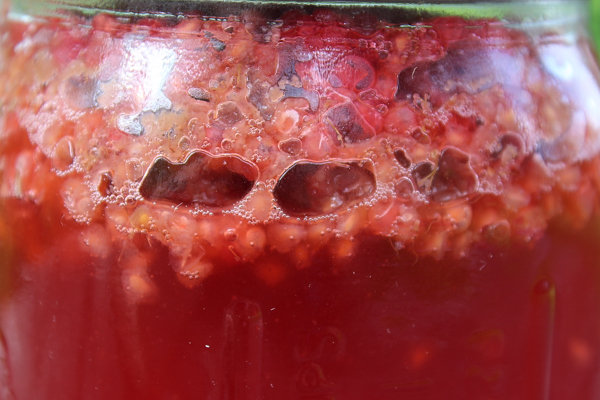
There are a lot of great reasons to make a micro-batch mead. For raspberry mead, a micro-batch is a great way to keep your costs down without sacrificing flavor. With just barely a handful of raspberries, you can make a quart batch of raspberry mead that is brimming with raspberry goodness.
It’s also a good way to see if a sweet and VERY fruity mead is your cup of tea.
All you need to start is a bit of honey, raspberries, a quart mason jar, and a mason jar fermentation kit. There are a number of brands to choose from. Any of these would work, for example.
I use a kit by Fermentools that looks a lot like a home brew setup, and if you choose to do bigger batches later you’ll need the rubber stopper and water lock that are included in the kit.
I’m hoping at some point to try out these silicone fermentation lids from Mason Tops because they look super easy to clean.
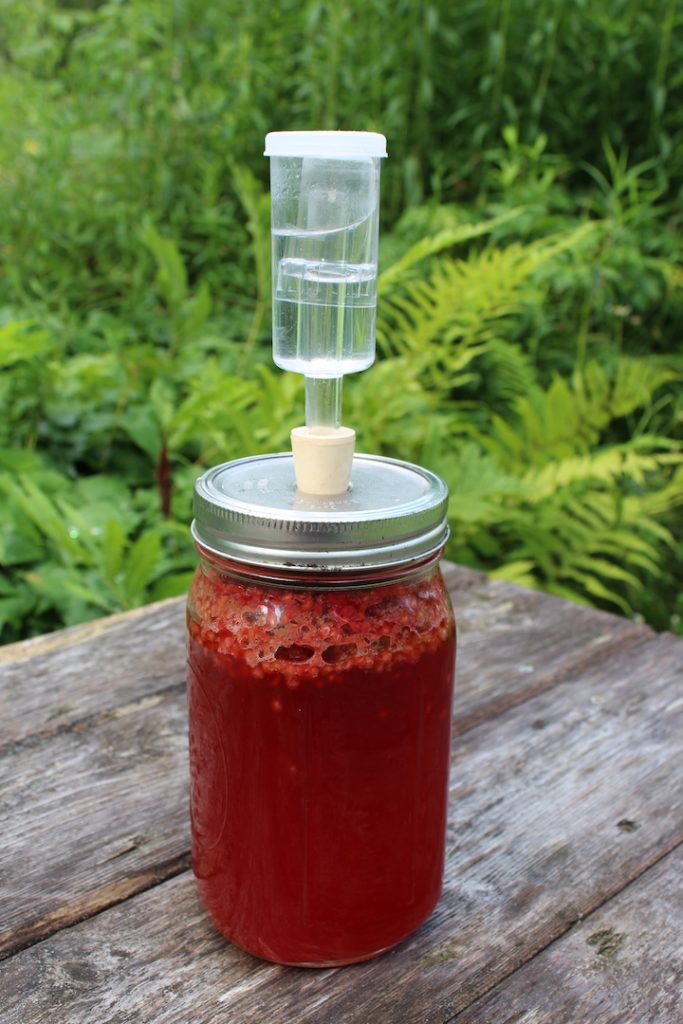
Start by adding a bit of honey to the bottom of a quart mason jar. The basic instructions for a one-quart batch of mead have you add between 2/3 of a cup of honey and 1 cup of honey to get the right ratio of honey to water in your jar. With the added fruit sweetness, stick to 2/3 of a cup.
I’ve tried a full cup for this recipe, and it was cloyingly sweet and just a hair shy of cough syrup. Adding 2/3 of a cup is more than enough for a sweet dessert mead, and if you’re looking for something drier, go with 1/2 cup.
For raspberries, I had a half-pint (one cup) easily at hand. They were super fresh, about 10 minutes old from my patch. One cup is all I could keep from eating out of hand before I made it back to the kitchen, but it was plenty for this micro-batch.
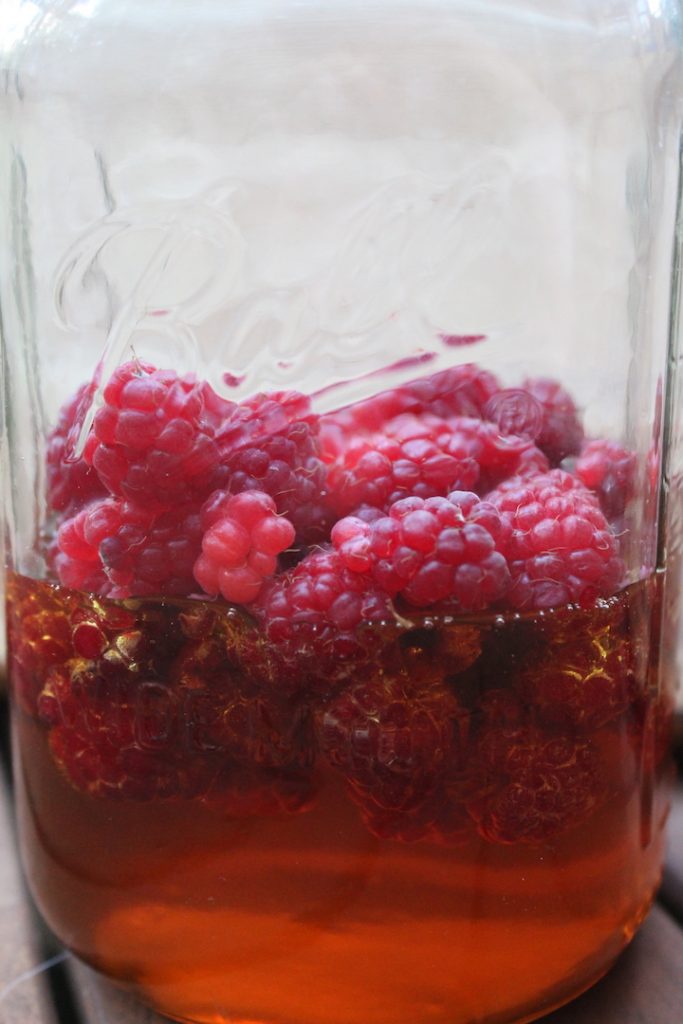
With honey and raspberries in the jar, getting your mead going is pretty effortless. Bring about 3 cups of water to a boil on the stove, then cool slightly for about 30 seconds before pouring it directly into the jar over the raspberries and honey.
Stir to dissolve the honey and incorporate the raspberries.
Once it’s cooled to room temperature, or at least cooled to 90 to 100 degrees so it won’t kill the yeast, add in a brewing yeast. For meads, I use packages of champagne yeast. One pack is enough to pitch a 5-gallon batch, so using the whole packet is overkill for a micro-batch.
I usually use about 1/4 of a yeast packet because it’s hard to actually extract less than that from a tiny packet. Dissolve it in room temperature chlorine-free water and pour it into your mason jar.
Related: How to Make One Quart of Mead (Micro Batch Method)
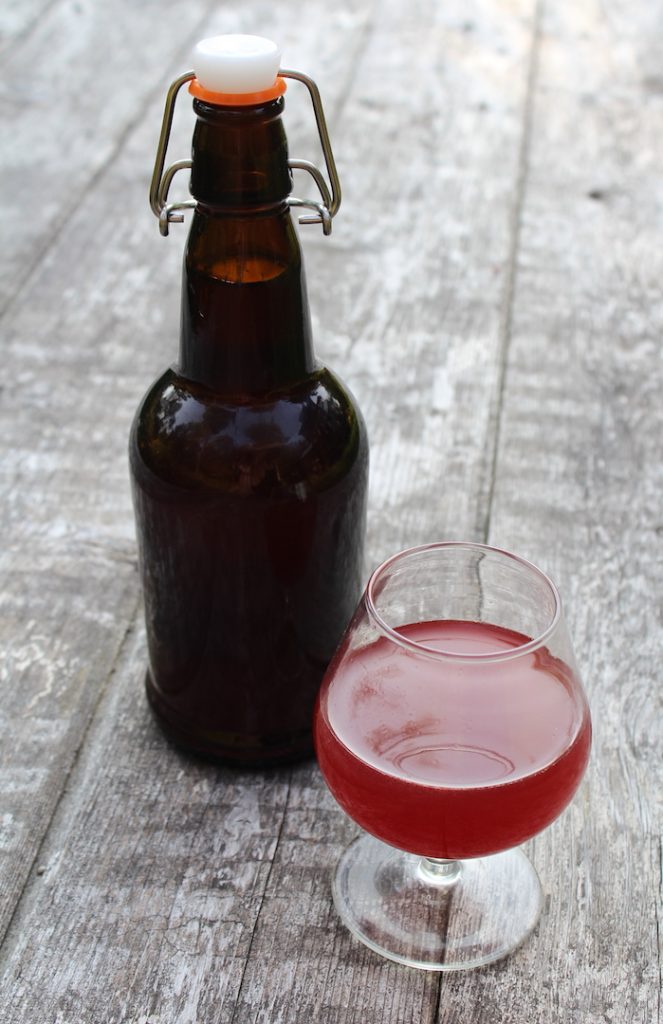
Once it’s all said and done you should have 2/3 cup honey, 1 cup raspberries, a bit under 3 cups of water and about 1/4 of a packet of champagne yeast in your mason jar. Be sure to leave about an inch of headspace to allow for expansion and bubbling during fermentation.
Add on your mason jar fermentation kit and allow it to ferment at room temperature, out of direct sunlight for about 6 weeks.
The initial fermentation phase can be a bit intense, so after the first week if any fruit has made it into your water lock, pop it off and clean it out. Be sure to get it back on tight for the rest of your fermentation time.
When fermentation is complete, carefully pour off the mead into another jar, leaving the sediment behind.
I bottle mine, and allow it to age in Grolsch bottles for at least 2 weeks, preferably a bit longer.
Then, enjoy!
If you’re looking for more details on how to make a micro-batch mead, you can read an introduction to the micro-batch method here.
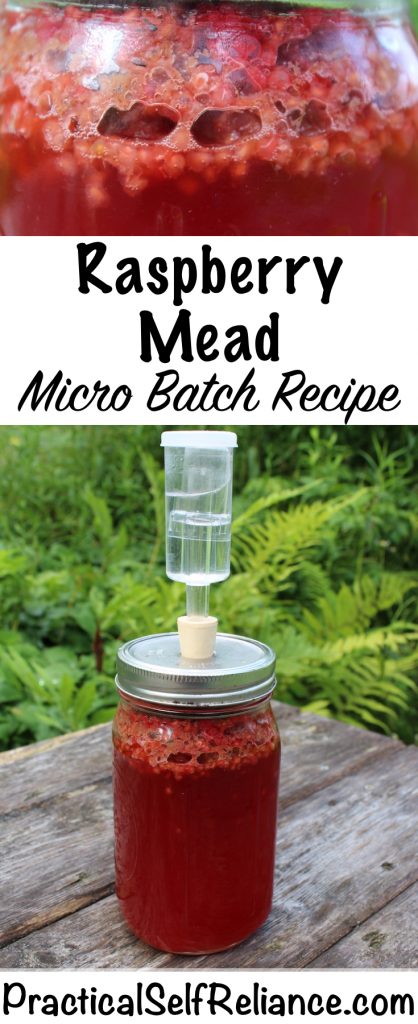



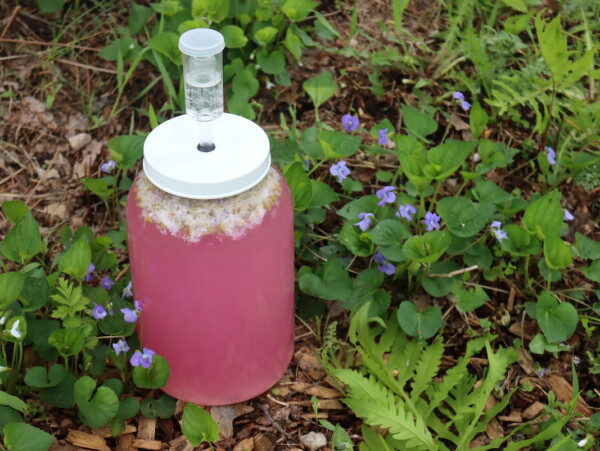
My first mead following your recipe only with blueberries. I hope it works!
Let us know how it works out for you.
This is Melomel. Mead is honey, only. When fruit is added it’s then classified as Melomel.
Specifically, when grapes and honey are fermented together, it’s not wine or mead, it’s Pyment.
Any idea what measure by teaspoons (or fractions thereof) 1/4 packet of yeast amounts to? Also, can micro-batch mead be safely stored in a jar? Can micro-batch wine? Thank you. Your website is wonderful and I am learning so much. But right now, I think I only know just enough to get myself into trouble if I’m not careful!
I’m honestly not sure what the exact measurement is for 1/4 packet but you could easily measure it out if you wanted to but it doesn’t need to be super exact. You can definitely do small batches of wine. Here is a post on that and it includes some links to specific small batch wine recipes as well. https://practicalselfreliance.com/small-batch-wine/
Hi Ashley! I followed your recipe yesterday and multiplied it by 4 to fit my 1 gallon jug but it’s been 12 hours and there ‘s only a little bubbling. Should I put more yeast or do anything differently? Thanks in advance!
I am assuming that you used an entire packet of yeast? If so that should be plenty. As long as there is some bubbling you should be fine. It’s still pretty early in the process. You can try moving it to a warmer location will which help the fermentation process.
I used 3/4 of the packet and then added the rest the next day, I hope that’s ok. Theres very little bubbling but I’ve moved it to a warmer location and will see how it goes from there! Thanks for your help!
You’re very welcome. Hopefully, that will do the trick.
Thank you Ashely, my raspberries are very productive and I have many in the freezer, so I think I’ll give this a try in a half-gallon Mason jar with my Easy Fermenter lid system and grolsch-style bottles for the secondary ferment. My question is, should the secondary ferment be done in the fridge (like I’ve done water kefir before) or is room temp the way to go?
You want to keep your mead at room temperature during the entire fermentation process.
Hey Ashley you don’t seem to rack for a second fermentation with this recipe, Is it optional?
Also, want to try this with watermelon, think it’s a good idea?
Hi Nick, this was written quite a while ago and definitely could use an update. (I’m a little more thorough on the instructions when I write these days, and I was much less so when I first started writing.) I usually rack to secondary, that’s optional, but always recommended. (If fruit are floating above the liquid line though, those need to be removed after a week or so, since exposed to air they’ll start to mold.)
For watermelon, believe it or not, that’s one of the tricky fruits. I’m actually working on finishing a watermelon wine/mead post now, hopefully, it’ll be up today (or later this week). Watermelon is incredibly susceptible to contamination, and you really need to sterilize the juice with Camden tablets for success. (I had MANY failures until I did that.) For that reason, it’s tricky to make as a micro-batch since Camden tablets are standardized to 1 tablet to a gallon of liquid.
Other than that, the other change is to use all watermelon juice for the liquid, since it has a really mild flavor. With raspberries you only use 1 cup to a quart, since they’re pretty intense.
Thank you so much for this reply and for the post, will read it and see if it’s up for my beginner skills. RIght now I have 1 full honey mead that I think turned to vinegar (tasted while racking it) and no fermentation and another batch of the 2/3 that is tasting and looking promisiong! Keep’em coming! ON another note, getting my pressure canner tomorrow. LAWD you making me spend girl! 😉 Have a good one.
Oh man! Congrats on your pressure canner. I love my baby, and use it all time. It seems like I’m taking it out to use every single week, once you have one, they really open up a lot of doors canning wise.
Finished writing that up quicker than expected. Posted today: https://practicalselfreliance.com/watermelon-wine/
Good afternoon Ashley. My first batch of raspberry mead is in the cupboard bubbling away. I’ll have a 5 gallon bucket of peaches soon. I see the recipe for the peach wine but could you use the peaches in place of the raspberries for the mead recipe So happy I found your site I’ve been going through all the things I want to make next. Thank you for making it all sound so easy, I’m super excited. Thank you Laurie
Wonderful, I hope it all turns out tasty for you!
Ma’am,
I am interested in making raspberry wine and I have lots of wild raspberries to use. How do you alter the recipe to make wine and not mead?
Here you go: https://practicalselfreliance.com/small-batch-wine/
Hi, first time home brewing anything here! My mead is just coming off its 6 week fermentation, and I rebottled it, but it tastes super alcoholic. Is this normal? Will it mellow after bottling?
Yes! At bottling time mead (and wine) taste pretty harsh. Bottle conditioning causes it to mellow and it’ll be much more balanced in a few weeks (or months). I’ve had a few batches taste harsh for as long as 6 months, then really mellow after that. Some of them seem to condition faster than others.
Hi Ashley,
New subscriber here, and learning to make fruit wine. How much Rasberries would I use and honey for a gallon of Raspberry mead, also if you have a recipe for lemon mead. Is it possible to just use a jar or bucket that does not have the regular ferment top on it. Just cover with cheesecloth and watch it?
Thank you
Regina
You can use a bucket covered with a towel for the primary, but after that you have to get a water lock on it so it doesn’t turn to vinegar. If you want to make a gallon, just multiply this recipe by 4. For a lemon mead, I’d suggest trying this lemon wine recipe but subbing in about 3lbs honey instead of the sugar: https://practicalselfreliance.com/lemon-wine/
Good luck!
Question,
Is it bubbly when you bottle it or is a regular wine bottle and screwtop okay for bottling?
I have 1 jar with raspberries and maple syrup, then one with blueberries and maple syrup brewing atm. (I can’t do honey.)
You need to use a vessel that is safe for bottling fermented drinks. So a wine bottle that is corked, beer bottles with caps, or flip-top bottles like this: Otherwise there’s a possibility that your bottle may explode from the pressure of built-up gases.
Hi Ashley!
Have you tried using the silicone fermentation lids for this? I was just looking at setting up a mead in my 1 gallon jug but thought it might be a good idea to try a few different small quart batches instead to see what flavour profile I like. I have plenty of those silicone lids knocking about but havent tried them for alcohol before. Honey is super expensive where I live so don’t want to waste it if the lids don’t work.
Cheers,
James
Yup, they work great! The only trick is you can’t really see the water lock bubble because it’s a different setup. If you’re watching that to determine when primary is over then you’ll have to look at different queues (bubbles in the mead itself, or just give it more time).
Awesome! Thanks Ashley. I’ll set up a few this week using some of your recipes then.
Great! Good luck!
Hey Ashley,
I love your posts! I’ve had a lot of fun reading them and I’m very excited to try some of this out! Will this recipe work for blackberries and strawberries? Also, I read one of your other articles about using herbs! I’m really interested in making medicinal meads. Do you have any recommendations for herbs to be paired well with strawberries or blackberries?
Yes, this will work great with strawberries or blackberries. As to the herbal part, it’s mostly what’s in season at the same time and flavors that sound like they might work (plus whatever you’re trying to accomplish medicinally) For strawberries, try strawberry elderflower, it’s lovely. For blackberries, maybe blackberry lemon balm?
Hi, I made this recipe but scaled up for a gallon container. This is my first time making mead so I have a question. Although most of my raspberries/sediment has sunk to the bottom, some of the raspberries, approx 1/4 or 1/5 is still at the top and according to the recipe I should bottle in 1 week. I am worried about how to bottle it bc I don’t have siphoning equipment and was counting on all the raspberries being at the bottom so I could pour it into the bottles. Is there a way to bottle it as it is now without siphoning equipment, or should I let it ferment longer until the last sediment drops? Or just buy siphoning stuff?
Sorry this is rlly long winded, thanks!
No worries. A fine mesh strainer will work to strain out the floating fruit. Lacking that, a scrap of old t-shirt works fine too, or cheesecloth, or a cloth napkin, coffee filter, etc. There are lots of options. Slowly pour it off through a filter to get the top floating stuff, but at the same time try to leave the very fine sediment at the bottom undisturbed.
I had the same thing happen to me – my raspberries were floating in my gallon jar and all my sugar had fermented away (specific gravity was around 1.002). I added more honey and strained the mixture into a (sterile) gallon jar and fermented for another week.
The two-part fermentation seems to have worked pretty well – I ended up with a 12% alcohol by volume fruity mead that goes pretty well with gin and homemade ginger beer
Oooh, do you think this would work with dried raspberries, Ashley? I would love to try it!
Yup! It should work fine with dried, freeze-dried or frozen raspberries…no problem!
Do you sterilize the jar before making the Mead?
I don’t sterilize anything, but I have a minority opinion. Just about everyone else does, but I’ve never found it necessary. You’re pouring boiling water into the jar in this recipe, and there’s plenty of living bacteria/yeast on the raspberries. A lot more than are on the jar. But, sterilization never hurts anything and all in all it helps to ensure a more consistent batch. The only real place I’ve found contamination to be a serious problem is in a racking cane/tube.
Hello Ashley, Nice job. I can’t wait for the snow to be gone. I wont to get my little elderberry twigs out and in the ground. This winter has been tough here in N.H. Your mead looks delicious . Can frozen berries be used? Thank you.
Of course. Frozen berries should work just fine.
Ashley,
Thank you for this recipe! I’ve long wanted to try my hand at making mead but didn’t want to tackle 5 gallons, or even one. So, this small batch seems a perfect way to learn and test the process.
I started a batch November 27th. I used the Easy Fermenter kit system. Initially, the yeast went crazy, but then I’d see no action. Reading your warning about a vent clogging, I gently swirled the jar at least daily. That cleared the seeds from the vent and it would go back to brewing away. The past two days, I don’t see any bubbling. Does this all sound like what should be expected?
Sounds like you’re right where you should be!
The first week or so, especially the first 3-4 days, is the “violent fermentation stage” where it really goes nuts. If you have a regular water lock, it sounds like popcorn popping as the bubbles jiggle it around on their way out. If you’re swirling it, you’re adding a bit of air into the ferment, which can actually promote more violent fermentation. I haven’t used the easy fermenter kit system myself, but if that worked to clear the blockage and get it going again, great.
It’s also ok, and my preferred method, to just take the lid off and wash it out. During the initial phase of fermentation, especially with pitched yeast (rather than wild yeast), the yeast are the dominant organism and they’re outcompeting anything else, so it’s ok to have the lid off just to wash it.
Later, like where you are, a lot of the sugars have turned to alcohol, and most of the yeast have died off. Now is the stage where it’s most susceptible to contamination (and turning to vinegar). At this point, it’s actually alcoholic and drinkable, though it’ll taste pretty rough. The next few weeks, the yeast will work slowly, and the flavors will refine. You wont see much action, but this slower phase is where the good flavors come from.
Sounds like everything is going perfectly. Let me know how it turns out!
Thanks, will do!
awesome post . I make a lot of meads myself, and i love to use the pure, raw flavors i find in nature.
Berries and honey to ferment into mead is a godsent to great drinks… 🙂
Thanks! And beautiful blog by the way.